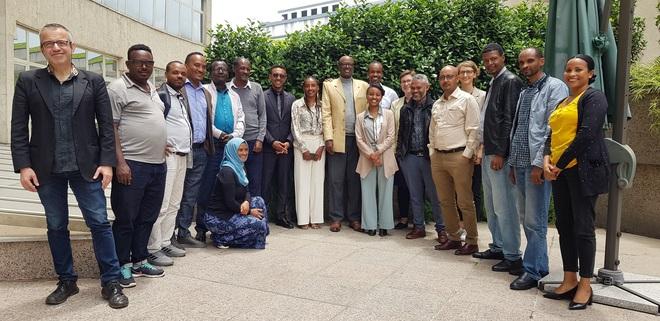Strengthening the capacity for inclusiveness in land use planning

Laying the groundwork for effective land use planning
The right to land is a fundamental right with implications for other rights, such as the right to food and the right to security. In recent times, high population growth rates, unregulated urban expansion, and poor resource use have led to land degradation, loss of biodiversity, and disputes over access. An integrated and participatory approach to land use and management is essential if resources are to be used sustainably and equitably in the future.
Stakeholders, including vulnerable and marginalised groups, are not aware of each other's needs and interests as well as of their own rights. This calls for the provision of relevant information so that their interests and needs are taken into account through their participation in land use planning processes.
The Human Rights-Based Approach (HRBA) to land use planning is central to this, as it promotes awareness of land rights and the ability of communities to claim and benefit from them. Similarly, a Gender Transformative Approach (GTA) to development and planning measures is needed to promote gender-equitable land tenure and encourage women’s participation in land planning processes. By supporting its partners in implementing these measures, the GIZ-implemented project Participatory and Integrated Land Use Planning (PILUP II) seeks to promote and strengthen the practice of participatory and integrated land use planning.
Understanding the root causes of the problem
Resolving land use issues and challenges requires balancing conflicting interests and reconciling competing objectives. The interests and tenure rights of smallholder farmers and pastoralists, women, local communities and urban dwellers are often minimised in relation to those of others. Opportunities to influence decision-making and secure their rights may be missed, and where loss of land leads to loss of livelihoods, housing, and food, this leads to increased poverty and inequality.
As part of its efforts to raise awareness among various regulations and participatory and integrated land use planning processes and approaches, the project organised a training on human rights and gender inclusivity in land use planning. This training of trainers was attended by participants from the federal ministries, civil society organisations and land bureaus in the Amhara, Benishangul Gumuz and Oromia regions.
Speaking on the occasion, the Director of the Socio-economic Rights Department of the Ethiopian Human Rights Commission, Dr Brightman Gebremichael, stressed that whenever there is a land use planning undertaking, a human rights approach should underpin all its stages so that the measures involve and benefit all the members of the community.
Hawi Asefaw, a young, passionate human rights officer and trainee, explains, ‘There is a gap in understanding land rights and other socio-economic rights as human rights because most people associate human rights solely with the rights to life, food, shelter, and self-determination.’ She added that a reluctance to use human rights-based and gender-transformative approaches to land-related issues can have negative consequences for the social and economic sectors. Emphasizing inclusion as a way to avoid and mitigate conflict, she remarked, ‘Focusing on a human-rights-based approach will enable us to leave no one behind and to minimise, mitigate and resolve land disputes. That is what I would like to strive to achieve in my future work.’
The benefits of integrated land-use planning
Land use plans that balance and harmonise economic, environmental, social, and cultural goals will better support sustainable development and further reduce poverty. They will also protect the tenure rights of vulnerable people and better balance competing land use objectives. Civil society organisations and local communities, including vulnerable and marginalised groups such as women, should not only be involved in the overall planning processes, but their interests and needs should also be actively consulted and incorporated.
Land use planning and decision-making processes are often not transparent, leaving certain interest groups worse off. In addition, inadequate compensation schemes lead to frustration among stakeholders and local communities, and planning and decision-making processes often fail to address the needs of women and other vulnerable groups. Involving local communities and stakeholders in land-use planning processes ensures that people know and can claim their rights, which is the basis for effective land-use planning.
The way forward
The training aims to inform participants about the added value of human rights-based and gender-transformative approaches to integrated land-use planning processes, and how these approaches can be applied in the development and implementation of integrated land-use plans. In addition, the trainees will be equipped to provide training on both approaches at the regional level to relevant key actors such as decision-making bodies, land authorities, land users and others affected by land use changes in the three pilot regions of the project, Amhara, Benishangul Gumuz, and Oromia.
Raising community awareness will ultimately help empower communities to claim and exercise their rights while strengthening the capacity of stakeholders to respect, protect, promote, and fulfil human rights.
About the Participatory and Integrated Land Use Planning Project
The Participatory and Integrated Land Use Planning (PILUP II) project, funded by the German Federal Ministry for Economic Cooperation and Development (BMZ) and implemented by GIZ, aims to integrate the needs of all sectors and stakeholders to promote sustainable and equitable land use based on human rights principles and with the full participation and involvement of local communities.
Author: Sefanit Minwuyelet